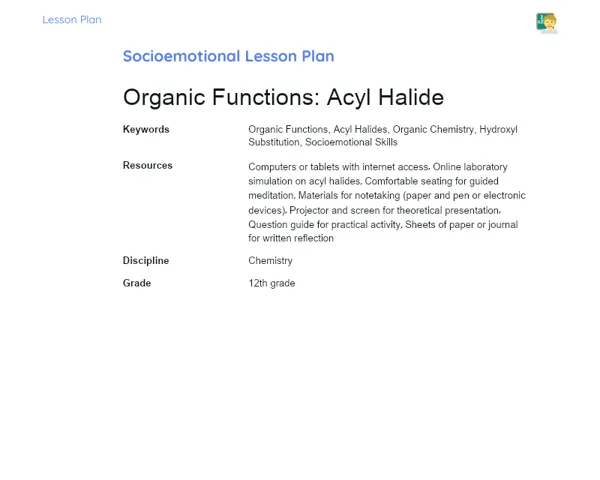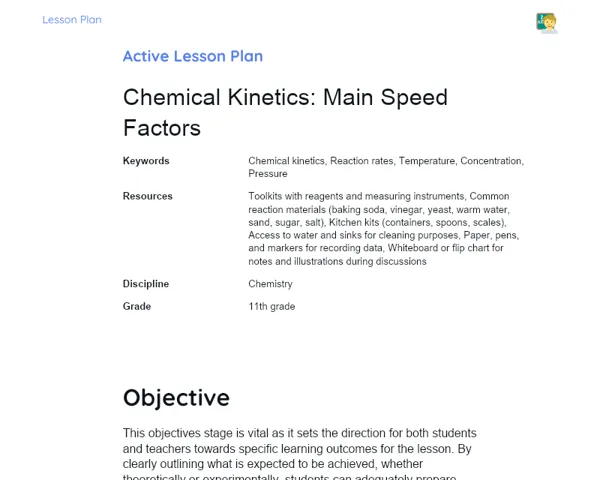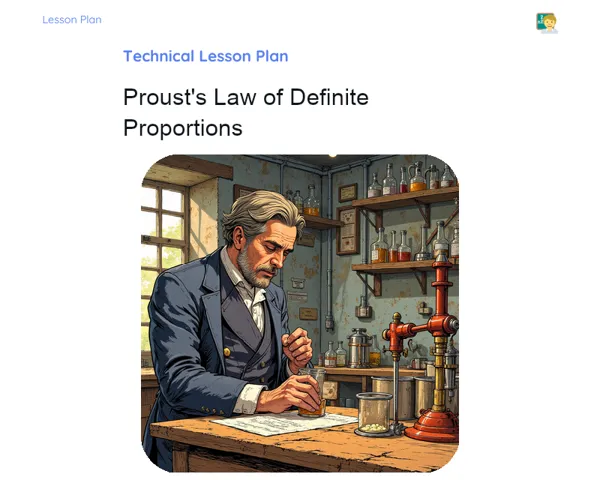Lesson Plan | Lesson Plan Tradisional | Solutions: Reaction Mixing
| Keywords | Solutions, Mixtures, Chemical reaction, Concentration, Molarity, Molality, Mole fraction, Stoichiometry, Limiting reactant, Precipitation, Chemical calculations, Practical applications |
| Resources | Whiteboard, Whiteboard markers, Multimedia projector, Computer with internet access, Printed copies of calculation problems, Scientific calculators, Chemistry textbook, Notepaper, Pens and pencils |
Objectives
Duration: (10 - 15 minutes)
This stage aims to equip students with a solid grasp of the fundamental concepts required to solve problems related to mixtures of solutions with various solutes and chemical reactions. By clearly laying out the main objectives, students will be able to concentrate on the skills they need to hone during the lesson, aiding their learning and retention of the material.
Objectives Utama:
1. Gain a clear understanding of how to mix solutions of different solutes and recognise when a chemical reaction takes place.
2. Learn to calculate the initial and final concentrations of the solutions involved in a chemical reaction.
3. Utilise stoichiometric principles to tackle practical problems related to mixtures and the reactions of solutions.
Introduction
Duration: (10 - 15 minutes)
This stage is designed to establish a foundation that illustrates the importance of understanding the mixtures and reactions of solutions. By linking classroom concepts with real-world instances and practical usages, students will become more engaged and motivated to learn.
Did you know?
Did you know that reactions between various solutions are employed in the water treatment sector to eliminate impurities from the water we drink daily? For instance, adding aluminium sulfate to contaminated water prompts a reaction that helps gather and clear suspended particles, rendering the water safe for consumption.
Contextualization
Begin the lesson by explaining that solutions are uniform mixtures of two or more substances, and that blending them can sometimes lead to a chemical reaction. Emphasise the significance of grasping these reactions, especially in scenarios like chemical labs, the pharmaceutical sector, and water purification, where mixing solutions is a routine practice.
Concepts
Duration: (40 - 50 minutes)
This stage aims to deepen students' understanding of the mixtures of solutions involving chemical reactions, focusing on how to accurately calculate the initial and final concentrations of the solutes involved. By covering key topics and tackling practical problems in class, students can apply theoretical concepts to real-life contexts, thereby enhancing their chemistry skills and problem-solving capabilities.
Relevant Topics
1. Definition of Solutions and Mixtures: Explain that solutions are uniform mixtures of two or more substances. Differentiate between solute and solvent, providing relatable examples (like salt dissolved in water).
2. Reactions in Solutions: Discuss how mixing solutions of distinct solutes can lead to a chemical reaction. Use relatable examples of common reactions, such as the formation of precipitates when combining silver nitrate and sodium chloride solutions.
3. Concentrations of Solutions: Talk about concentration, molarity (M), molality (m), and mole fraction. Clarify how to calculate the initial and final concentrations of solutes involved in a reaction.
4. Stoichiometry of Reactions in Solutions: Explain how to apply stoichiometry to determine the amounts of reactants and products in reactions occurring within solutions. Include practical examples with balanced equations.
5. Calculation Methods: Show a step-by-step approach on how to calculate the initial and final concentrations of solutions after the reaction. Use numeric examples and chemical equations to elucidate.
To Reinforce Learning
1. A 0.5 M silver nitrate (AgNO3) solution is mixed with a 0.2 M sodium chloride (NaCl) solution. What is the concentration of the remaining ions after the formation of silver chloride (AgCl) precipitate?
2. Calculate the final concentration of a solution resulting from mixing 100 mL of 1 M HCl with 200 mL of 0.5 M NaOH, knowing that the reaction between them is complete and results in water and salt.
3. Determine the final concentration of ions in a solution achieved by mixing 150 mL of 0.3 M copper sulfate (CuSO4) solution with 250 mL of 0.1 M sodium hydroxide (NaOH) solution, considering that copper hydroxide (Cu(OH)2) precipitate is formed.
Feedback
Duration: (20 - 25 minutes)
The aim of this stage is to review and reinforce student learning by providing thorough feedback on the questions solved. Through discussion, the teacher can clarify doubts, solidify concepts, and ensure every student comprehends the required steps to resolve analogous issues. Furthermore, engaging students through reflective inquiries promotes a deeper and more analytical grasp of the subject matter.
Diskusi Concepts
1. Question 1: A 0.5 M silver nitrate (AgNO3) solution is mixed with a 0.2 M sodium chloride (NaCl) solution. What is the concentration of the remaining ions after the formation of silver chloride (AgCl) precipitate? Explain that the reaction occurring is: AgNO3 + NaCl → AgCl(s) + NaNO3. To solve, first calculate the number of moles of each reactant. The quantity of AgNO3 is 0.5 mol/L * volume (L) and that of NaCl is 0.2 mol/L * volume (L). Identify the limiting reactant and compute the amount of AgCl formed. The remaining ions will be from the excess reactant and soluble products (Na+ and NO3-). 2. Question 2: Calculate the final concentration of a solution resulting from mixing 100 mL of 1 M HCl with 200 mL of 0.5 M NaOH, knowing that the reaction between them is complete and produces water and salt. Clarify that the reaction is HCl + NaOH → NaCl + H2O. Compute the moles of HCl (0.1 L * 1 mol/L) and NaOH (0.2 L * 0.5 mol/L). Identify the limiting reactant and the amount of NaCl produced. The final concentration of NaCl will be calculated based on the total volume of the blend (300 mL). 3. Question 3: Determine the final concentration of ions in a solution obtained by mixing 150 mL of 0.3 M copper sulfate (CuSO4) solution with 250 mL of 0.1 M sodium hydroxide (NaOH) solution, considering the formation of copper hydroxide (Cu(OH)2) precipitate. State that the reaction is CuSO4 + 2 NaOH → Cu(OH)2(s) + Na2SO4. Calculate the moles of CuSO4 (0.15 L * 0.3 mol/L) and NaOH (0.25 L * 0.1 mol/L). Identify the limiting reactant and the quantity of Cu(OH)2 formed. The remaining ions will include those from the excess reactant and soluble products (Na+ and SO4^2-).
Engaging Students
1. Why is it important to identify the limiting reactant in a chemical reaction? 2. How can you anticipate whether a reaction between two solutions will lead to the formation of a precipitate? 3. What are the necessary steps to calculate the final concentration of ions in a solution post-reaction? 4. Can you think of other practical scenarios where mixing solutions and understanding the resultant reactions is vital? 5. What was the most significant challenge you faced when tackling the mixture solution problems? How can we address it?
Conclusion
Duration: (10 - 15 minutes)
The purpose of this stage is to revisit the key points covered in the lesson, reinforcing student understanding and ensuring they recognise the importance of the content studied. This segment also serves to tie theory to practice, underscoring the relevance of the concepts in everyday situations and professional contexts.
Summary
['Solutions are uniform mixtures of two or more substances.', 'A chemical reaction can occur when mixing solutions of different solutes.', 'Understanding the concepts of concentration, molarity, molality, and mole fraction.', 'Applying stoichiometry to ascertain the amounts of reactants and products in reactions occurring within solutions.', 'Methods of calculation to find the initial and final concentrations of solutions post-reaction.']
Connection
Throughout the lesson, theoretical concepts were linked to practical applications via illustrative examples and methodically solved problems. The application of solution concepts and chemical reactions in industries, laboratories, and water treatment was demonstrated, enabling students to envision the real-world application of the subject matter explored.
Theme Relevance
Comprehending the mixtures of solutions and their reactions is critical in several sectors of daily life and industry. For example, in water treatment, chemical reactions are employed to purify drinking water. Additionally, in chemical analysis labs and the pharmaceutical sector, understanding mixtures and solution reactions is essential for developing new products and medications.



